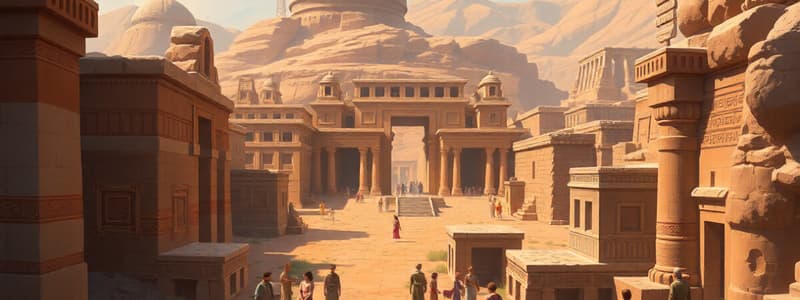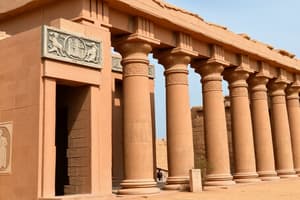Podcast
Questions and Answers
Flashcards are hidden until you start studying
Study Notes
Early Civilizations
- The first civilizations emerged in Mesopotamia and Egypt.
- These civilizations developed systems of writing, complex social structures, and new technologies.
- Key features of early civilizations include:
- complex social organizations: societies divided into social classes, with rulers at the top, and farmers, artisans, and laborers below
- advanced cities: served as centers for trade, governance, and cultural development
- specialized labor: allowed for the production of surplus goods
- monumental architecture: pyramids, ziggurats, temples, and public works
- record keeping: writing systems used to record events, laws, and information
- organized religion: provided a sense of community and purpose
Mesopotamia
- Located in a fertile region between the Tigris and Euphrates Rivers in present-day Iraq
- The earliest civilizations in Mesopotamia appeared around 3500 B.C.E.
- Sumerians were the first to develop a system of writing, known as cuneiform.
- Akkadians established the first large empire in Mesopotamia.
- Later empires, such as the Babylonians and Assyrians, dominated the region.
- Hammurabi's Code was one of the first written legal codes, and set precedent for later law codes in the ancient world.
- Other features of Mesopotamian societies include:
- irrigation systems to support agriculture
- wheel, the plow, sailing, and bronze.
- cities like Ur and Babylon
- belief in many gods
Ancient Egypt
- Located in the Nile River Valley in North Africa
- Emerged around 3100 B.C.E
- The Pharaoh was the absolute ruler, considered a god-king.
- Key features of Ancient Egypt include the construction of
- massive pyramids
- temples
- mausoleums.
- hieroglyphics was the writing system used to record information.
- Egyptian civilization was influenced by the belief in life after death
- Egyptian society featured a complex social hierarchy, with scribes, priests, merchants, and farmers.
- The nile river and the annual flooding provided fertile land for agriculture
Indus Valley Civilization
- Located in the Indus River Valley (present-day Pakistan and northwestern India)
- Flourished from 2500 to 1700 B.C.E.
- Cities like Harappa and Mohenjo-daro were well-planned and had advanced sanitation systems.
- The Indus script was a system of writing that has not yet been fully deciphered.
Ancient China
- Emerged in the Yellow River Valley (Huang He River) and Yangtze River valley.
- The Shang Dynasty (1600 – 1046 B.C.E.) marked the beginning of the Bronze Age in China and significant political and cultural development.
- The Zhou Dynasty (1046 – 256 B.C.E.) was the longest-lasting Chinese dynasty, known for:
- strong bureaucracy
- development of Confucianism
- iron tools
- the mandate of heaven
Ancient Greece
- Emerged in the Aegean Sea, from 2700 B.C.E.
- Established city-states (poleis) with their own governments, laws, and cultures.
- Greek civilization was dominated by Athens and Sparta.
- Ancient Greeks achieved significant advancements in:
- philosophy
- mathematics
- science
- art
- literature
- democracy (Athens)
Ancient Rome
- Located on the Italian peninsula
- The Roman Republic (509 – 27 B.C.E.) was established after the overthrow of the Etruscan monarchy.
- The Republic expanded to control most of the Mediterranean region.
- The Roman Empire (27 B.C.E. – 476 C.E.) was established after the Roman Republic collapsed.
- Rome achieved many accomplishments in
- law
- engineering
- architecture
- military organization
- trade
- language, which influenced many languages spoken today.
- The Roman Empire fell due to a combination of factors
- economic problems
- political instability
- military challenges
The Middle Ages
- Period between the fall of the Roman Empire in the West (476 CE) and the beginning of the Renaissance (14th century).
- Characterized by:
- the rise of Christianity
- the establishment of feudalism
- the development of medieval trade routes.
- During this period, a number of powerful empires emerged in Europe and Asia, including:
- the Byzantine Empire
- the Islamic Caliphate
- the Carolingian Empire
- the Holy Roman Empire
- The Crusades were a series of religious wars fought between European Christians and Muslims.
- The Black Death (1346-1353) was a devastating pandemic that killed millions of people.
The Renaissance
- A period of renewed interest in classical art, literature, and philosophy.
- The Renaissance began in Italy in the 14th century.
- Key figures of the Renaissance include:
- Leonardo da Vinci
- Michelangelo
- Raphael
- Niccolò Machiavelli
- William Shakespeare
- The Renaissance laid the groundwork for the Scientific Revolution and the Age of Exploration.
The Age of Exploration
- A period of exploration and discovery that began in the 15th century
- Propelled by advances in shipbuilding, technology, and motivation for trade routes.
- Led to the European colonization of the Americas.
- Key figures:
- Christopher Columbus
- Ferdinand Magellan
- Vasco da Gama.
The Scientific Revolution
- A period of scientific advancement that began in the 16th century
- Characterized by a new emphasis on observation, experimentation, and reason.
- Key figures include:
- Nicolaus Copernicus
- Galileo Galilei
- Isaac Newton
The Enlightenment
- A period of intellectual and cultural movement in the 18th century
- Emphasis on reason, individualism, and skepticism
- Key figures include:
- John Locke
- Jean-Jacques Rousseau
- Immanuel Kant
- Adam Smith
The Industrial Revolution
- A period of rapid technological advancement that began in Great Britain in the late 18th century
- Characterized by the development of new machines, factories, and power sources.
- Led to the growth of cities, mass production, and the rise of capitalism.
The 20th Century
- The 20th century was marked by:
- two world wars
- the rise of communism
- the Cold War
- the development of nuclear weapons
- the rise of globalization
- the development of new technologies.
- Key events of the 20th century include:
- The Russian Revolution (1917)
- The Great Depression (1929-1939)
- World War II (1939-1945)
- The Cold War (1947- 1991)
The 21st Century
- Characterized by:
- the growth of the global economy
- the rise of new technologies
- increasing globalization
- environmental challenges such as climate change
- increased communication and information sharing
- complex issues of terrorism, political instability, and economic inequality.
Studying That Suits You
Use AI to generate personalized quizzes and flashcards to suit your learning preferences.




